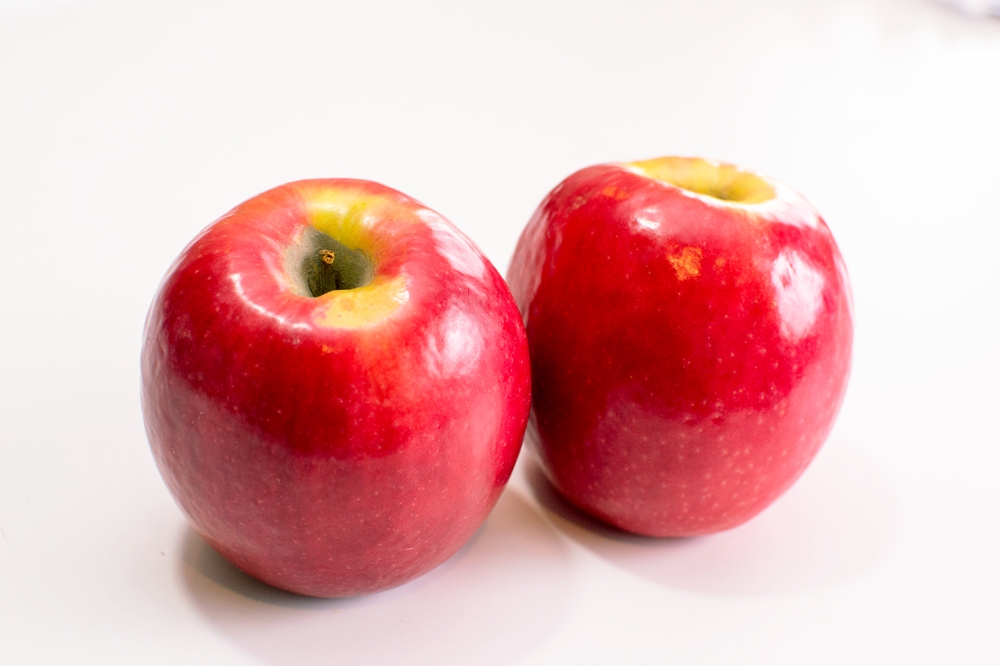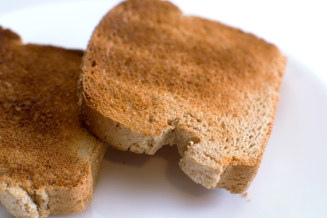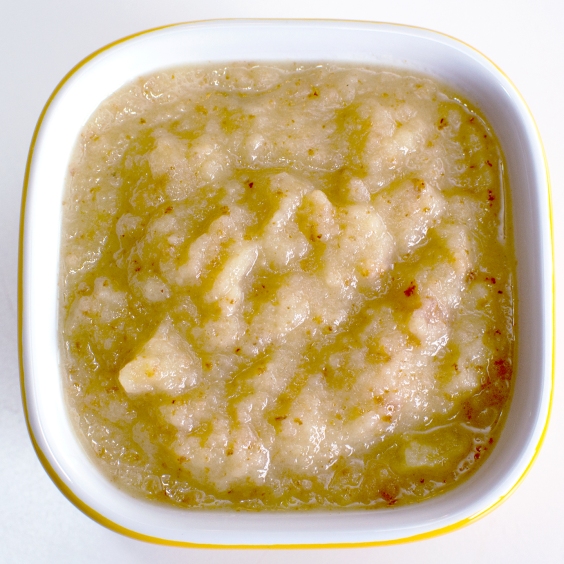Apple Muse was an extremely popular medieval dessert, likely enjoyed in some form at every level of society due to the availability of the three core ingredients.
There are many versions of this recipe found in a variety of manuscripts but often under different names: Appylmoes, apulmos, appillinose, etc. All versions I’ve found call for apples, almond milk and honey and are to be thickened with bread crumbs or egg yolks. Some versions add spices for sweetness and flavor, others simply for color. Depending on the recipe and personal taste, Apple Muse (or perhaps “Mousse”) could be thin like applesauce or thick and mushy like a bread pudding. There is a lot of room here for interpretation.
As always I like to provide some basic history about certain ingredients, especially when presenting a dish so common to the the Medieval world.
Apples
Apples were probably the most accessible fruit in medieval Europe. Every culinary manuscript contains a large percentage of apple-based recipes. Desserts, mostly.

I am the type of person who will get derailed by a tiny detail such as which kind of modern apple might be considered most authentic to the Middle Ages. After much research and deliberation I’ve found that there aren’t any. No modern varieties of apples existed back then. A few period varieties can be found but are grown in specialty antiquity/heirloom or research orchards in Europe. Like today, there were many types of apples, some better for eating raw and others used only for baking. Generally speaking, medieval apples were smaller than ours and not quite as sweet.
Some of the most popular varieties in the 13th through 15th centuries were the Copstard, Queene, Pippin (an ancient variety, not just any Pippin) and Old Pearmain. There are thousands of varieties of modern apples but only a handful are available to me locally. Among those that are most common in U.S. grocery stores the varieties I believe are best to use are the Golden Delicious, McIntosh and Granny Smith (a descendent of an ancient French crab-apple). Many popular apples like Pink Lady, Jonagold and Gala are actually descendants of the Golden Delicious. At the end of the day, any apple you want to use will probably do.
If you’re interested in reading up on apple varieties, Orange Pippin is a fantastic place to start!
Honey
Until sugar became more accessible and affordable, honey was the sweetener everyone relied on. It was highly valued in medieval society, not only for its flavor but also for its medicinal properties. Honey has been an important worldwide agricultural product pretty much since the beginning of time.
Further reading on the history of honey:
Medieval Beekeeping
The Honey Association
Almond Milk
Almond milk is one of the most common ingredients in medieval cooking and is a must for any period culinary enthusiast. Due to the large number of days when animal products like cow’s milk and meat broth were off-limits, almond milk was often the go-to substitute.
You can read up on the history of almond milk and even learn how to make it at home by reading my previous posts:
Almond Milk the Medieval Way
Almond Milk the Medieval Way: Pt. 2
The Recipe
This recipe is from Harleian ms 279, a manuscript written in approximately 1430. It was transcribed by Thomas Austin and combined with another Harleian manuscript and 3 extracts. Austin’s collection was published in 1848 under the title Two Fifteenth-Century Cookbooks.
Apple Muse. Take Appelys an sethe hem, an Serge hem þorwe a Sefe in-to a potte; þanne take Almaunde Mylke & Hony, an caste þer-to, an gratid Brede, Safroun, Saunderys, & Salt a lytil, & caste all in þe potte & lete hem sethe; & loke þat þou stere it wyl, & serue it forth.
My translation:
Apple Muse (Mousse)- Take apples and boil them, and force them through a sieve into a pot; then take Almond milk and honey, and add, and grated bread, saffron, sandalwood, & a little salt, & put all in the pot & let them boil; & see that you stir it well, & serve it forth.
Ingredients
The measurements below are a result of more than one attempt at this recipe to find a pleasant texture somewhere between runny and congealed.
- 2 apples
- 1 cup unsweetened almond milk
- 3 tbsp honey
- 1/2 cup bread crumbs (2 slices of toast)
- Pinch of saffron
- Pinch of salt
- Red sandalwood powder for color (optional)
Step ONE
“Take apples and boil them, and force them through a sieve into a pot;”
Core and peel your apples and boil them in water until they are nice and soft, easy to mash. Depending on how many apples you use this could take about 10 minutes. Drain the water.

Without the use of modern blenders, purees were made by mashing and pushing the food through a sieve, a type of strainer. While you’re welcome to sieve your boiled apples by hand, it will save a lot of time and energy if you use a blender or food processor. You could even mash with a mortar and pestle. It doesn’t matter much which tool you use as long as your puree is relatively smooth. No need to be a hero.
Step TWO
“…take Almond milk and honey, and cast thereto, and grated bread, saffron, sandalwood, & a little salt, & cast all in the pot & let them boil; & see that you stir it well”
Add the remaining ingredients and simmer long enough to heat it through and thicken. This takes around 5-7 minutes.
A few notes:
- Adjust the honey according to taste. Three tablespoons is perfect, in my opinion, if using a sweeter variety of apple.
- Commercial bread crumbs a
 nd Panko should be avoided at all costs when making this recipe. These products aren’t generally advised for authenticity purposes anyway, but while they are acceptable in other recipes, the texture is what will make or break this dish. Experience taught me that using the ultra-fine breadcrumbs results in an apple muse that is extremely thick and unpleasant. Instead, toast a couple pieces of bread and dry them out before crushing (or sieving) into crumbs.
nd Panko should be avoided at all costs when making this recipe. These products aren’t generally advised for authenticity purposes anyway, but while they are acceptable in other recipes, the texture is what will make or break this dish. Experience taught me that using the ultra-fine breadcrumbs results in an apple muse that is extremely thick and unpleasant. Instead, toast a couple pieces of bread and dry them out before crushing (or sieving) into crumbs. - Saffron does add a bit to the flavor. However, as was typical in medieval cooking, it was intended to be used as a food colorant. You could throw a pinch right into the pot or steep it in the almond milk ahead of time. Saffron is pricey so if you want to omit this ingredient you certainly may, or you could even replace it with a little yellow food coloring.
- Sandalwood powder can be difficult to find in its edible form. During the Middle Ages it was commonly added to food to color it red, not enhance the flavor. By all accounts the sandalwood is either unpleasant or not even noticeable so its use is entirely optional here. If you still desire that red color, use food coloring. But you’ll need enough to turn it red, not pink!
Step THREE
Serve it forth!
Apple Muse is great served right out of the warm pot, but I personally prefer eating it cold. There is no indication in the recipe of any spice toppings to dress the Apple Muse for serving. I suppose you could sprinkle some Ceylon cinnamon or nutmeg on top, but I left mine plain.

This is a pretty simple and tasty dish, but it is a bit…odd. It is not quite an applesauce, not quite a pudding, not quite an oatmeal. The flavor is wonderful regardless of texture. The super-thick version I made was just awful, but that might just be my texture preference. I don’t believe Apple Muse was intended to be runny, but you could easily adjust the measurements to suit your personal taste. Have fun with it and don’t be afraid to experiment!
Sources
- Friedman, David and Elizabeth Cook. Cariadoc’s Miscellany: Concerning Trees and Their Fruit, 1988.
- Gaudio, Monica. Boke of Gode Cookery: A Tale of Two Tarts. 2005
- Lydia’s Flexitarian Kitchen: Apple Muse. 2013
- Maitre Chiquart. Old Cook: Fruit in Medieval Europe
- Matterer, James. Boke of Gode Cookery: Apple Muse. 2000.
- Medieval-Recipes.com: Fruit. 2010.
- Merwin, Ian. Some Antique Apples for Modern Orchards. Cornell University, New York.
- Orange Pippin, Ltd. http://www.orangepippin.com. 2015
Wonderful and interesting article. Thanks
LikeLike